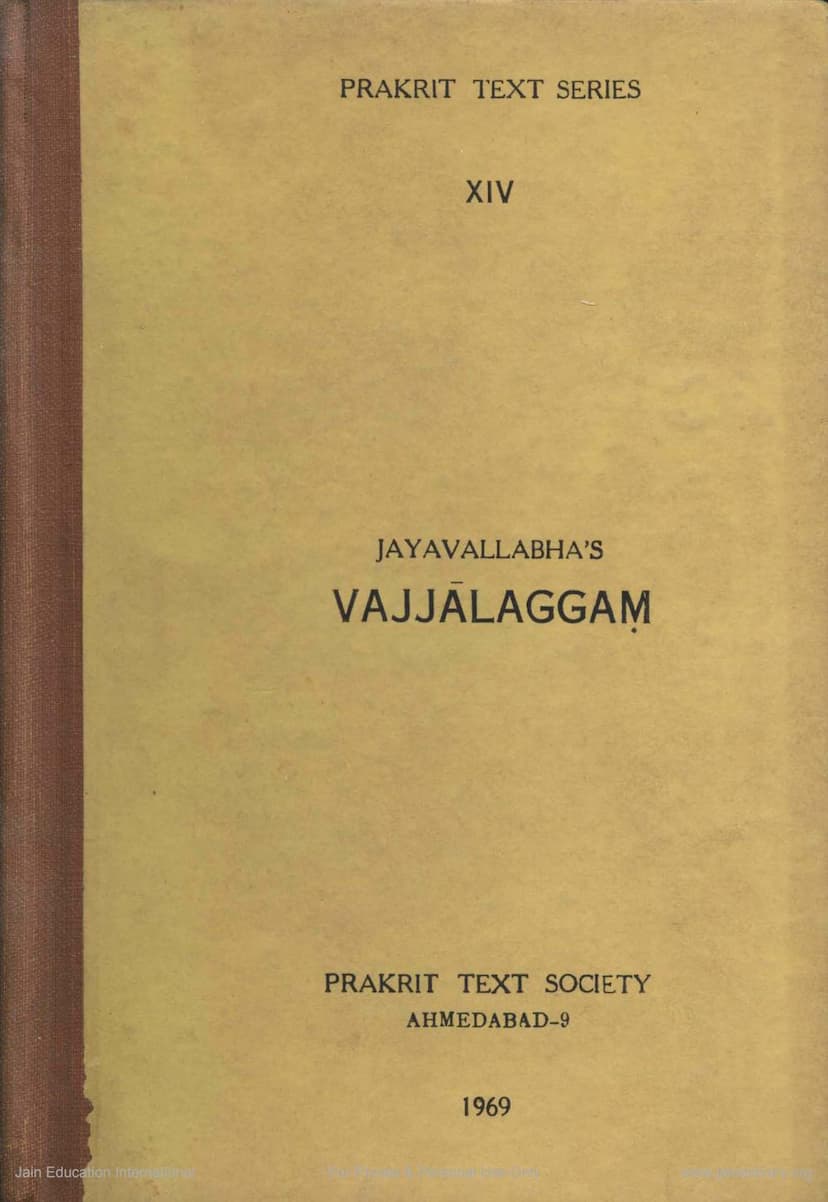Vajjalaggam
Added to library: September 2, 2025

Summary
The text provided is an extensive scholarly edition of Jayavallabha's Vajjalagga, a significant work in Prakrit literature. Here's a comprehensive summary in English, drawing from the introduction, content, and notes:
Title and Author: The work is titled Vajjalagga, and its author is identified as Jayavallabha. The name "Vajjalagga" itself is explained as a collection of "groups" (vajjās) of stanzas (gāthās) arranged topically, with each group dealing with a single subject. The author also gives a specific name to this anthology: Jayavallabha.
Commentary and Edition: This edition includes the Sanskrit commentary of Ratnadeva. The work was edited with an introduction, English translation, notes, and glossary by Prof. M. V. Patwardhan.
Date of the Work: The Vajjalagga is placed between 750 AD (based on external evidence, specifically a stanza from the Gaüḍavaho by Vākpatirāja) and 1337 AD (the date of Ratnadeva's commentary). The internal evidence points to a date after the 1st century AD, as it references Susruta's work on medicine.
Language: The language of the Vajjalagga is primarily Jaina Māhārāṣṭri Prakrit, with a significant influence of Apabhramśa. This indicates a later phase in the development of Prakrit language compared to earlier works like the Paumacariya.
Subject Matter and Structure: The Vajjalagga is a compilation of Prakrit stanzas, modeled after Hāla's Gathāsaptasati, but notably distinguished by its topical arrangement of stanzas into sections called vajjās. The author states that the stanzas included are "choice" selections from various poets. The subject matter is broadly categorized into Dharma (morality/righteousness), Artha (worldly success), and Kāma (pursuit and enjoyment of worldly pleasures), following the traditional goals of human life in ancient Indian thought. While Dharma occupies a subordinate position, Artha and Kāma are given almost equal importance. The text contains evocative descriptions, literary merits, figures of speech, and explores various sentiments (rasas), with a notable emphasis on erotic matters (śṛngāra rasa).
Content and Scope:
- Original Extent: It is believed to have originally contained 700 stanzas, similar to Hāla's Gathāsaptasati.
- Vulgate Extent: The printed vulgate version, including additional stanzas found in some manuscripts, contains 795 stanzas (and Ms. C has even more, totaling 990). The amplification of anthologies by later scribes is a common phenomenon.
- Number of Sections (Vajjās): While the original Vajjalagga is estimated to have had 48 sections, the vulgate version printed in this edition contains 95 sections.
- Sources: The Vajjalagga is an anthology and not an original creation of a single author. It draws from various poets, and many of its stanzas are found in Hāla's Gathāsaptasati and other Prakrit collections like the Chappaņņayagāhāao. It also quotes from Alamkāra works, though the VL itself is not explicitly mentioned in those works.
- Literary Form and Merits: The stanzas are predominantly gāthās composed in the Āryā metre. They are considered muktaka (self-contained isolates), forcefully and tersely presenting a complete idea or situation. The author's views on poetry, its composition, recitation, and appreciation are outlined in the introductory stanzas. The work exhibits high literary merit, showcasing skillful selection of stanzas, sophisticated use of figures of speech, and subtle hidden meanings conveyed through suggestion.
- Religious and Mythological Allusions: Although compiled by a Jain author (Jayavallabha) and containing homage to Jain deities like the Omniscient Jina and Śrutadevi, the Vajjalagga features numerous allusions to Brahmanical (Hindu) religion and mythology, including references to the Hindu Trinity (Hari, Hara, Brahman), Śiva worship, Vāmana avatāra, Viṣņu's activities, the Sāgara mathana, and the life and exploits of Kṛṣṇa. This is interpreted as an indication of a liberal mind, free from narrow sectarian outlook.
Manuscripts Consulted: The edition relies on a critical analysis of several manuscripts, including those from the L. D. Institute of Indology (Ahmedabad) and the Bhandarkar Oriental Research Institute (Poona). Ms. C is noted for its unique features, including the attribution of the commentary to Dhanasāra instead of Ratnadeva, the inclusion of additional stanzas, and variations in the sequence of sections.
Key Themes and Characteristics:
- Topical Arrangement: A defining feature, distinguishing it from Hāla's Gathāsaptasati.
- Secular and Erotic Content: The work predominantly deals with secular themes and a significant portion focuses on erotic matters (Kāma), though Dharma and Artha are also covered. The erotic content is generally conveyed subtly through suggestion rather than explicit description.
- Literary Excellence: The stanzas are praised for their epigrammatic terseness, vivid imagery, forceful expression, and skillful use of figures of speech (like upamā, rūpaka, śleṣa).
- Influence of Apabhramśa: The language shows a marked influence of Apabhramśa, indicating its compilation during a transitional period in Prakrit literature.
- Refined Taste: The editor highlights Jayavallabha's literary judgment and suggests he may have been more of a redactor than a mere compiler, possibly even composing some stanzas himself.
In essence, Jayavallabha's Vajjalagga is presented as a refined anthology of Prakrit verses that balances the depiction of worldly success and love, while also offering moral wisdom and insights into the cultural and religious milieu of its time. The scholarly edition by M. V. Patwardhan provides a critical apparatus for understanding this complex and beautiful work.